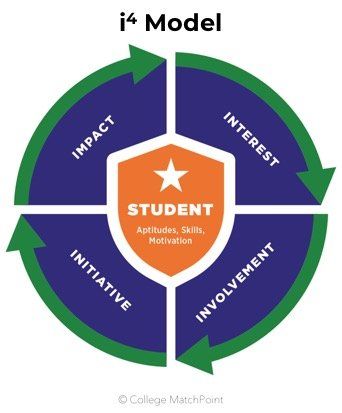This page is licensed under Creative Commons under Attribution 4.0 International. Anyone can share content from this page, with attribution and link to College MatchPoint requested.
How Student Involvement Can Develop During the High School Years
We developed the i4 Framework after years of working with students to help guide their involvement. It is something that anyone can follow. One of the best parts of our i4 framework is that it's circular in nature. A student may have involvement with very little interest, or they may be making an impact in an activity they did not initiate. The idea is to jump in, try things out, and participate. In other words—engage. Once they do that, all four I's will begin to develop in their own right.

To help start the process, we'll look at how engagement might develop throughout high school. As you read, remember: This is a loose plan and not a step-by-step guidebook. Every student is different and is on his or her unique journey.
Getting Started: Interest and Involvement
Freshman and sophomore years. This is the time to explore! Encourage your student to join school clubs or athletic teams or volunteer at a local non-profit in a related area of interest. And it doesn't end when the school bell rings: Summer programs, camps (including CIT programs), and travel are great options for exploring interests during the summer. Pre-college programs on a college campus can be helpful for students to experience what it's like to live on a college campus and determine what they want in a college. Even hobbies and personal projects are valuable means of gaining experience.
Here are some great examples of activities that are perfect opportunities for freshmen and sophomores:
- Take a coding class
- Try out for the school play
- Sign up for a church/synagogue retreat
- Babysit the neighborhood kids
- Pursue creative writing projects
Junior and senior years. If your student has identified an area of interest, they can explore ways to deepen their involvement through a leadership position, a part-time job, or an internship. Students gain valuable experience from researching, applying to, and interviewing for jobs or internships. Other valuable activities include academic research and independent projects that allow students to begin creating a portfolio of work. This can be especially impactful on college applications, even as potential essay topics.
Some students develop clear interests earlier in their high school careers, while some take a little longer. Your student can jumpstart an interest at any time—just be sure to encourage their exploration along the way.
When Interests Deepen: Initiative and Impact
Participation is a great start, and we encourage it throughout high school. But by junior or senior year, it's time to take it step further. Many students find that they develop greater skills and confidence by increasing the initiative they take within their activities and by strengthening the impact of their involvement.
Initiative. Demonstrating initiative often involves starting with an idea and then taking steps to make it a reality. Traditionally, we might think of initiative as founding a club or starting a new school program. And while those and other formal leadership roles certainly do the trick, there are other ways to show initiative. The key is to turn ideas into actions, no matter the context. Here are a few examples:
- Proposing a service project to fellow club members and then reaching out to the organization to coordinate student service
- Making a new playlist and dance routine to add some fun into the daily team warm-up
- Organizing a study group for a particularly tough AP exam and setting a weekly agenda to keep everyone on track
- Moving from journal writing to starting a blog
- Creating a neighborhood summer camp for kids
- Stepping up to a leadership role in the church/synagogue youth group
- Working with a teacher to create an independent study project in an area of interest
- Coaching younger kids (or being a referee) in a sport you love
- Organizing a cheek swabbing event for the local organ donation charity
Impact. To identify what impact your student is having, ask yourself: "What is different because of my student's involvement/ideas/questions?" Revisiting the examples of initiative, let's look at what their impact might be:
- The proposed service project led to ten new members joining the club (thus increasing the potential future impact of service projects)
- Team morale increased and the team went on to come in second in the state championships that year
- Students in the AP study group all scored 4 or 5 on their exams
- The blog has gained 1,000 followers
- 20 kids signed up for the neighborhood summer camp
- The youth group had the greatest participation ever at the yearly social because of your event planning ideas
- The independent study project has turned into a potential career interest
- Parents of kids you coached wrote you a card describing the positive impact you had on them
- 100 people signed up to become organ donors
Of course, initiative won't always lead to impact—and that's okay—but be sure to follow through on your student's actions and encourage them to highlight their impact whenever possible.


